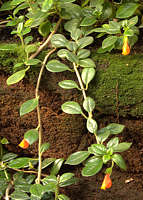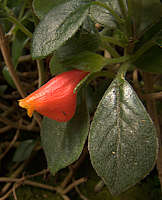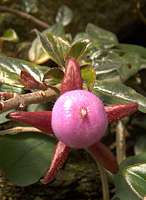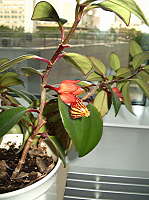Gesneriaceae Richard & de Jussieu 1816
The Gesneriaceae is a family of 150 genera and around 3200 species of tropical dicotyledenous flowering herbs, shrubs and trees with a few temperate species.
The irregular flowers have five sepals and five petals which may be joined at their base to form a tube. Leaves and flowers may be softly hairy and are mostly opposite or whorled, but can be alternate. The ovary can be either inferior or superior and usually forms a rounded or ovate capsule contaiing numerous seeds, although some species bear berries. All Gesneriads have fibrous roots, but some also have tubers or rhizomes as storage organs and some species have aerial stolons. Many species grow naturally as epiphytes or in depressions and crevices on rocks.
The Gesneriad Family includes many popular houseplants with a degree of succulence from the genera Aeschynanthus, Columnea, Gloxinia, Nematanthus, Saintpaulia and Streptocarpus. These plants are mostly not xerophytic and require regular watering and frost-free conditions, but most are undemanding. Many hybrids and selected cultivars are available.
The Gesneriad Society maintains a register of Gesneriad hybrids.
|
Aeschynanthus Jack, 1823 (Lipstick Plant)
is a genus of about 140 trailing plants or small shrubs with epiphytic and climbing habits, found in India to South-East Asia and the Borneo archipelligo. Leaves are opposite and succulent or leathery or in some species quite soft and non-succulent. Leaves and stems may be slightly pubescent. Flowers are generally red and attractive to sunbirds. Aeschynanthus are free-flowering plants, suitable for hanging baskets.
|
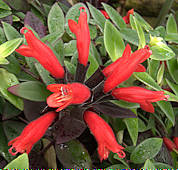
Aeschynanthus lobbianus Hooker 1846
Syn. Aeschynanthus pulcher (Blume) G.Don
This trailing plant has quite succulent glossy green leaves arranged alternately on dark stems. Clusters of red flowers with a dark, almost black calyx, open together. The flowers and calyx are slightly pubescent.
Native to Borneo and Java.
|
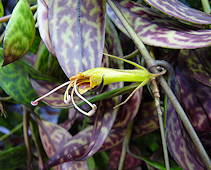
Aeschynanthus longicaulis Wallich 1839
This trailing plant has quite succulent green leaves with dark marbling and purple markings on the undersides. The flowers are greenish-yellow and open one at a time.
Native to Malaysia, Thailand and Vietnam.
Aeschynanthus longicaulis is one parent of the hybrid Aeschynanthus x 'Black Pagoda' which has rather similar leaves and clusters of orange flowers.
|
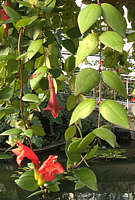 |
Aeschynanthus pulcher D. Don 1837
from Malaysia is a showy succulent plant for a hanging basket. Plants are propagated from stem cuttings, typically rooting at leaf nodes and easily rooted in a glass of water.
Sometimes considered to be a variety of A. radicans.
|
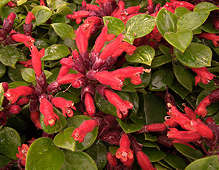 |
Aeschynanthus radicans Jack 1823
is an epiphytic vining plant from Malaysia and Java. The leathery green leaves offset the tubular, scarlet flowers. All parts are slightly pubescent. Pruning the stems emcourages new growth. This species is popular as a conservatory plant and for hanging baskets. It appreciates humidity and bright light, although not full sun. An open potting mixture with added sphagnum moss or bark simulates their natural habitat.
|
Alsobia Hanstein 1854
This genus includes two species of tender mat-forming stoloniferous succulent plants.
Native to Mexico, Guatemala and Costa Rica.
|
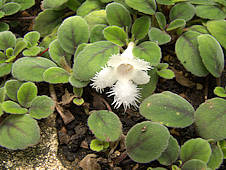 |
Alsobia dianthiflora (H.E. Moore & R.G. Wilson) Wiehler 1978 (Lace Flower Vine)
Syn. Episcia dianthiflora H.E. Moore & R.G. Wilson 1954
This species has bright green velevety leaves with purplish venation and white funnel-shaped flowers with deeply fringed petal margins and some light purple markings within the throat.
Native to tropical rain-forests of central South America and in cultivation requires constant warmth.
Alsobia punctata has purple spotting on the petals, which have less frilly margins than A. dianthiflora.
|
Chirita Buchanan-Hamilton ex D. Don 1822
includes up to 150 species distributed from India to South-East Asia and the Malay Archipeligo. About two thirds of the species come from China. They have clusters of showy tubular flowers with five, usually rounded, petal lobes in shades of purple, yellow and white. The leaves of some species are attractively marked with silver. Chiritas can be propagated from leaf cuttings.
|
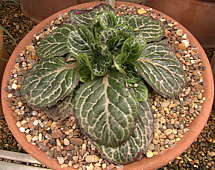 |
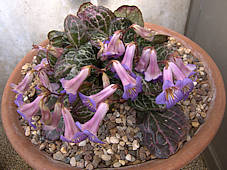 |
Chirita liboensis W. T. Wang & D. Y. Chen 1985
Syn. Primulina liboensis Mich.Möller & A.Weber 2011.
|
Chirita liboensis has hard, stiff glossy leaves with prominent silver veining and serrated margins forming 8 in diameter stemless rosettes. Some varieties have all-green leaves. The throats of the pale purple flowers are marked with yellow and dark purple veins. Their outer surface is pubescent.
Chirita liboensis is native to South-East Guizhou province of China, growing on rocks in forested hills.
|
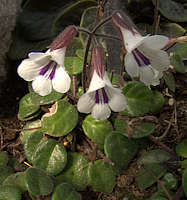 |
Chirita tamiana Burtt 1999
is a delightful miniature Gesneriad with rosettes of pubescent succulent leaves and stems, similar to those of a Saintpaulia. The white flowers, whose throats are marked with purple, resemble those of a Streptocarpus. Native to Vietnam.
|
Codonanthe Hanstein 1854 (Bellflower Vines)
Name: Greek for bellflower.
The genus includes 20 species of tropical American trailing plants and sub-shrubs with quite succulent but hard-surfaced leaves. The small scented flowers are usually white, sometimes with colour or spotting in the throat. They are pollinated by humming birds. Flowers are followed by colourful berry-like fleshy, dehiscent capsules containing 2 seeds.
Codonanthe are associated with ants, often growing on anthills where they help to stabilise loose soil. The ants help to distribute the ant egg-like seeds by carrying them to a new location, especially when migrating. Some species of Codonanthe are epiphytic.
Codonanthe species can be propagated from stem cuttings which root at their nodes, and require an open compost such as orchid seedling compost. Several hybrids have been made between Codonanthe and Nematanthus.
|
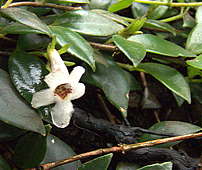 |
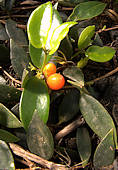 |
Codonanthe gracillis Hanstein 1854 (Bellflower Vine)
This trailing species has small pointed waxy leaves which are quite fleshy and succulent. The stems can reach over 6ft in length. White flowers with a dark throat are produced freely and are followed by ornamental orange berries.
Native to Southern Brazil. Good for a hanging basket or wall pot.
|
Columnea Linnaeus, 1753
Named for: Fabio Colonna 1567-1640, Italian botanist.
is a genus of about 70 trailing plants or small shrubs from the Caribbean, Mexico and South America to Ecuador. Flowers are tubular, sometimes fish-shaped and brightly coloured in shades of red, orange and yellow, sometimes with stripes. Flowers and other parts of the plant are often pubescent.
Columnea are free-flowering plants, suitable for bright window ledges and hanging baskets although full sun is best avoided. Their natural lifestyle is epiphytic and heavy, soggy soils should be avoided. A free-draining bark based orchid compost often works well for this type of plant. As with other succulent plants, avoid over-watering. A cool winter promotes flowering. Columneas are propagated from stem cuttings. There are numerous named cultivars and hybrids.
|
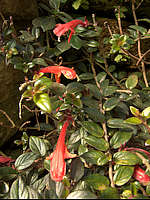 |
Columnea x banksii Lynch 1918 = C. oerstediana x C. schiedeana
Named for: GH Banks, botanist & hybridizer.
This artificial hybrid was raised by GH Banks in 1918 at the University Botanic Garden, Cambridge, as a cross between
C. oerstediana from Costa Rica and C. schiedeana from Mexico.
The woody stems bear small dark green ovate leaves. The bright red flowers are pubescent and produced in greatest abundance during the first half of the year. A very tolerant, easy to grow plant.
|
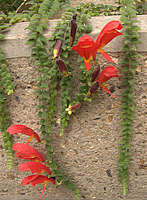 |
Columnea gloriosa Sprague 1911 Syn. Columnea microcalyx Hanstein 1866
Trailing stems carry pairs of opposite heart-shaped succulent leaves. All parts including the yellow-throated red flowers are pubescent. Flowers are followed by white berries.
Native to Costa Rica, SanJose and Honduras.
|
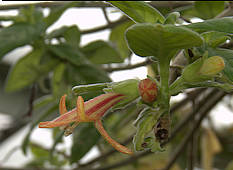 |
Columnea harrisii (Urban) Britton ex Morton 1944
Syn. Columnea hirsuta f. harrisii Urban 1901
Named for: William Harris, (1860 - 1920) Irish botanist, Superintendant of the Public Gardens & Plantations in Jamaica.
A trailing plant with woody stems bearing deeply-veined soft ovate leaves with a covering of fine hairs. Pale yellow flowers are longitudinally striped with orange and are markedly pubescent.
Native to Jamaica.
|
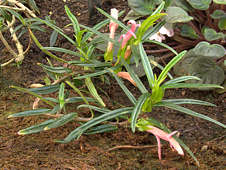 |
Columnea linearis Oersted 1858
from Costa Rica is a training sub-shrub with opposite lanceolate succulent leaves whose upper surface bears a longitudinal groove. The pink to purple tubular flowers are carried erect. The seeds are within pale pink berries.
|
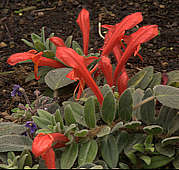 |
Columnea oerstediana Klotzsch ex Oersted 1861
All parts including the red flowers are pubescent. Native to Costa Rica, French Guiana and Brazil..
|
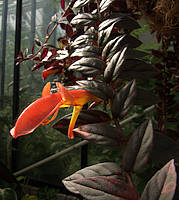 |
Columnea x Midnight Lantern
A trailing hybrid Columnea with glossy dark purple, almost black foliage and slightly pubescent orange flowers.
|
Gloxinia L'Héritier 1753
The genus Gloxinia has expanded and contracted through various revisions, the latest of which is supported by molecular data. As currently constituted, the genus includes three species of tropical rhizomatous herbs with raceme-like inflorescences. These plants originate in the Andes of South America, although Gloxinia perennis is also naturalised in Central America and the West Indies.
"Gloxinia" persists as a popular name for several plants formerly included in the genus, notably Sinningia speciosa commonly marketed as "Florists Gloxinia" and for several plants from other distantly related plant families from the Order Lamiales. The hardy tuberous plant Incarvillea delavayi (Garden Gloxinia) belongs to the Trumpet Creeper Family Bignoniaceae. The Mexican perennial vine Lophospermum erubescens Syn. Asarina erubescens (Creeping Gloxinia) belongs to the Figwort Family Plantaginaceae Syn. Scrophulariaceae.
|
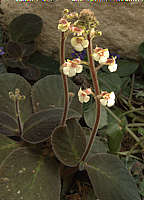 |
Gloxinia erinoides Roalson & Boggan 2005 Syn. Koellikeria erinoides
The dark green, heavily veined leaves have scalloped edges and about as fleshy and succulent as an African violet. Long flower stalks produce a raceme of small white flowers whose throats are marked with pink. Their perfume is reminiscent of coconut. All parts of the plant are slightly pubescent
Naturally distributed from Costa Rica to Bolivia.
|
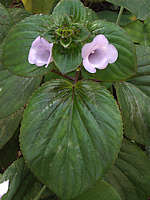 |
Gloxinia perennis Fritsch 1894 (Canterbury Bells)
This is the type species for the genus Gloxinia. It's origin is probably in the Andes of South America and it's wide distribution in Central America and the Caribbean probably reflects naturalisation. The large bushy plant grows from a scaly rhyzome and produces a dense raceme of pink to violet flowers.
|
The third species, Gloxinia xanthophylla Roalson & Boggan 2005
from Ecuador and Peru, has fibrous roots and no rhyzome. It produces a branching raceme of white flowers.
|
Nematanthus Schrader 1821
Name: Greek nema, mematos = thread plus anthos = flower, referring to the thread-like pedicel.
is a genus of about 30 trailing or climbing sub-shrubs from tropical South America. They are often called "goldfish" plants or "clog plants", referring to the shape of the flowers in shades of red, orange and yellow. The flowers are attractive to humming birds. The trailing foliage of some species makes them suitable subjects for hanging baskets, but others form small shrubs with a woody base.
Nematanthus are tolerant plants for a bright window ledge although full sun is best avoided. As with other succulent plants, avoid over-watering. In their habitat they are often epiphytic and a porous open medium suits them in cultivation. A long day length promotes flowering so they generally flower during the summer, unless day length is prolonged under artificial lights. Propagate from stem cuttings.
|
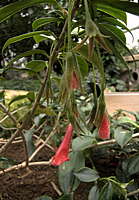
|
Nematanthus crassifolius Wiehler 1981
This shrubby succulent plant has pointed, glossy dark green leaves and pendant red flowers on long pedicels. All outer surfaces of the flower and pedicel are hairy.
Native to Brazil.
|
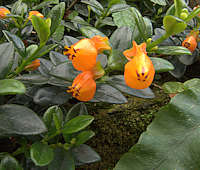
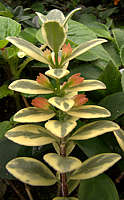
|
Nematanthus gregarius Denham 1974 (Clog Plant, Goldfish Plant)
Syn. Hypocyrta radicans Klotzsch & Hanstein 1864 N. radicans HE Moore 1973 (nom. illeg.)
is a shrubby succulent plant to 2ft tall, with glossy dark green succulent leaves and small orange flowers in the classic "goldfish" shape. The tips of the petals are marked with brown. All parts are smooth.
Native to Brazil.
Bottom left: a variegated form of N. radicans.
|
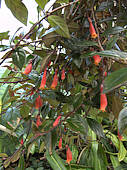 |
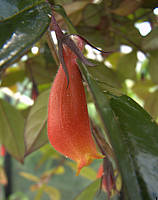 |
Nematanthus x "Black Magic"
(N. wettsteinii x N. 'Stoplight' = (N. longipes x N. fritschii))
a Nematanthus hybrid, with succulent glossy dark green leaves and a trailing habit suitable for a hanging basket. The large orange flowers are slightly pubescent.
|
Petrocosmea Oliver 1887
A genus of small rosetted plants superficially similar to African Violets, from mountains of China and Taiwan (Formosa) where they often growi in shade on mossy limestone rocks or in mossy forests. Most species prefer cool conditions. The rounded leaves, petioles and flower stems are pubescent.
|
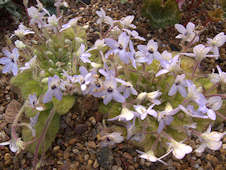 |
Petrocosmea grandiflora
Grows on limestone cliffs at elevations of over 6000 ft, so tolerant of dry cold and suitable for a cold frame. Native to South-East Yunnan Province of China, a biodiversity hot spot.
|
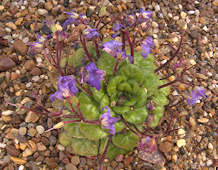 |
Petrocosmea minor
Grows on limestone rocks in forests at elevations of 3000 ft to over 7000 ft. Native to South-East Yunnan Province of China. |
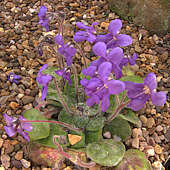 |
Petrocosmea nervosa
Grows on rocks in forests 1000 ft - 9000 ft in South-West Sichuan Province and North-West Yunnan Province of China.
|
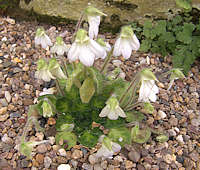 |
Petrocosmea cryptica Shaw 2011 Syn. Petrocosmea rosettifolia C.Y.Wu ex H.W.Li 1983
The plant grows as a tight rosette of 1.5in ovate leaves. Leaf surfaces have hairs arising from pustulate bases.
Native to China.
|
Sarmienta Ruíz & Pavón 1794
This genus is probably monotypic for Sarmienta scandens from South America.
|
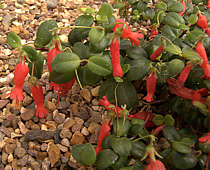 |
Sarmienta scandens Persoon 1805 Syn. Sarmienta repens Ruíz & Pavón 1794
This evergreen, creeping subshrub has thin, woody stems tending to root at the nodes where they touch the ground. The opposite, ovate, succulent leaves have distinctive notches either side of their tips. The slightly swollen tubular red flowers with spreading tips, are formed from five joined petals. Flowers are pubescent and with exserted stamens. The flowers are attractive to hummingbirds and are followed by berries.
An epiphytic plant, native to temperate rainforest of Chile and adjacent parts of Argentina.
|
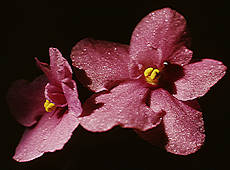
Saintpaulia Wendland 1893 (African violets)
Named for: Baron Walter von Saint Paul-Illaire (1860-1910)
African violets are popular undemanding flowering plants with quite fleshy succulent leaves and petioles. Leaf margins, stems and even the leaf surface are often pubescent. All wild species have blue-violet flowers. Recent revisions have reduced around 20 species to 9 species, 8 subspecies, and 2 varieties.
Native to Tanzania and Kenya, especially the Usambara, Nguru and Uluguru Mountains but also the coastal lowlands. Numerous cultivars and hybrids have been produced, with a wide range of flower colours including shades of maroon, purple, blue and white and variegated petals. Only yellow flowers had eluded the plant breeder until very recently (1992). Double flowers are a recent innovation.
|
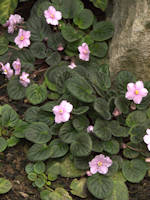
Saintpaulia ionantha var. grotei
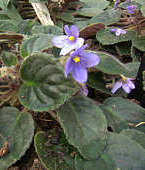
Saintpaulia ionantha var. ionantha |
Saintpaulia ionantha H. Wendland 1893 Syn. Saintpaulia kewensis
This species has succulent, pubescent, heart-shaped dark green leaves with deeply incised venation and reddish-brown petioles. Plants are free-flowering with several (4-5) single white to blue and dark violet flowers produced on each peduncle. Eight sub-species are recognised.
Native to the Usambara Mountains in Tanzania. Thanks to habitat destruction this species is considered endangered. Saintpaulia ionantha is ancestral to most cultivated African violets, with selection and propagation of variable and mutant seedlings providing white and pink flowers and foliage in various shades of green. Hybridization between other species has provided further diversity. Commercial use is restricted to the horticultural trade which propagates large numbers of African violets as undemanding house plants.
The potting mixture should be allowed to dry out between waterings. A new plant can be propagated from a single leaf with its stem, which should be buried in potting mix to the point where the stem joins the leaf base.
|
Sinningia Nees 1825
Named for: Wilhelm Sinning (1792-1874), gardener at the Botanische Gärten der Friedrich-Wilhelms-Universität Bonn.
Most of this group of about 60 herbaceous plants have large globular tubers. Brightly-coloured tubular flowers are common and attractive to humming birds, bees and moths. Sinningia brasiliensis is bat-pollinated. Many species originate in Brazil but others are distributed across South America from Argentina to Mexico. Sinningia speciosa with relatively large flowers is commonly sold as a Gloxinia. Numerous hybrids have been made between Sinningia species.
|
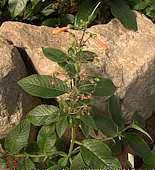 |
Sinningia aggregata Wiehler 1975
A vigourous shrubby plant with aromatic, slightly sticky foliage arising from a large surface tuber. In its habitat, the large tuber may grow on the surface of rocks and would presumably happy potted on the surface for display. A spike of tubular red, orange or yellow flowers, arranged in whorls, is produced on a long stem. Many hybrids have been made with this species. Native to Brazil and Paraguay.
|
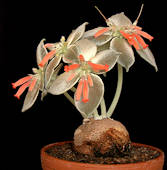
3D animation |
Sinningia leucotricha Hoehne 1956. Syn. Rechsteineria leucotricha
(Cardinal flower, Brazillian Edelweiss)
from Brazil, is the most widely grown truly succulent Gesneriad, a tuberous plant producing simple branches that bear a cluster of leaves covered in silvery-white hairs. In the Spring, orange to red tubular flowers are produced in the centre of the leaf clusters.
The tuber should be planted on the surface as a caudiciform and can get quite large (10in). It is possible to propagate the plant by dividing the tuber. As the tuber acts as a storage organ, this plant tolerates a surprising amount of neglect. Reduce water during winter dormancy.
|
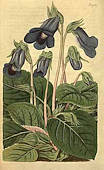 |
Sinningia speciosa (Loddiges) Hiern 1877 (Florist's Gloxinia, violet slipper gloxinia)
Syn. Ligeria speciosa Decaisne 1848, Gloxinia speciosa Loddiges 1817
Name: Latin speciosa = beautiful, splendid
This perennial with a subterranean tuber has deciduous rosettes of slightly pubescent, deeply-veined dark green leaves and white, magenta, purple or bluish bell-shaped flowers, sometimes with throats in a contrasting shade. The large leaves are quite brittle. Although often grown with the tuber buried it can be raised for display and is capable of growing to a diameter of 8 inches.
Native to the warm, humid Atlantic coastal forests of Brazil.
Left: Gloxinia speciosa Loddiges as illustrated in Curtis's Botanical Magazine 44 1817, typical of a wild plant.
|
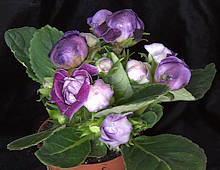 |
There is much diversity within the population of wild plants which has allowed plant breeders to develop a wide range of flower colours and forms.
The wild form of Sinningia speciosa has been greatly "improved" by horticulturalists and is marketed with large velvety flowers in a range of reds, pinks and purples and forms with bicoloured or spotted petals. The tuber requires a dormant period after flowering when it should be kept dry. Watering should always be from below, avoiding getting water on the foliage.
|
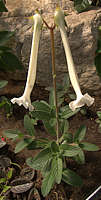 |
Sinningia tubiflora Fritsch 1894 (Hardy White Gloxinia)
A tuberous perennial with slightly pubescent deciduous foliage and stems that smell unpleasant when crushed. The long (3 in) white flowers, on very long flower stems, are sweetly fragrant with a hint of citrus and pollinated by sphinx moths. The large underground potato-like tubers spread by stolons so are best confined to a container in a warm climate. The tubers can be planted on the surface for display in a pot.
This drought-tolerant plant needs a cool, dry winter dormancy followed by full sun to promote flowering. In places with a warm winter it may fail to flower. Despite the common name, the tubers can be damaged by frost if the ground freezes. The tubers will also be damaged by cold, wet conditions. Native to Argentina and Uruguay.
|




























